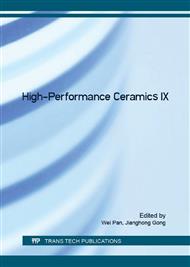[1]
DDL Chung, Electromagnetic interference shielding effectiveness of carbon materials, Carbon. 39 (2001) 279-285.
DOI: 10.1016/s0008-6223(00)00184-6
Google Scholar
[2]
D Micheli, R Pastore, G Gradoni, et al, Reduction of satellite electromagnetic scattering by carbon nano-structured multilayers, ACTA Astronaut. 88(2013) 61-73.
DOI: 10.1016/j.actaastro.2013.03.003
Google Scholar
[3]
P Liu, Y Huang, L Wang, et al., Hydrothermal synthesis of reduced grapheme oxide-Co3O4 composites and the excellent microwave electromagnetic properties, Mater. Lett. 107(2013) 166-169.
DOI: 10.1016/j.matlet.2013.05.136
Google Scholar
[4]
B Wang, J Zhang, T Wang, L Qiao, F Li, Synthesis and enhanced microwave absorption properties of Ni@Ni2O3 core shell particles, J Alloy Compd. 567(2013) 21-25.
DOI: 10.1016/j.jallcom.2013.03.028
Google Scholar
[5]
W. Zhou, X Hu, X Bai, et al, Synthesis and electromagnetic, microwave absorbing properties of core-shell Fe3O4-poly (3, 4-ethylenedioxythiophene) microspheres, ACS Appl. Mater. Interfaces. 10 (2011) 3839-3845.
DOI: 10.1021/am2004812
Google Scholar
[6]
DL Ridpath, DA Wright, Electrical conductivity of reduced barium titanate crystals, J. Mater. Sci. 5 (1970) 487-491.
DOI: 10.1007/bf00556035
Google Scholar
[7]
X. W. Yin, L. Kong, L. T. Zhang, L. F. Cheng, N. Travitzky, P. Greil, Electromagnetic properties of Si-C-N based ceramics and composites, Int. Mater. Rev. 59(2014) 326-355.
DOI: 10.1179/1743280414y.0000000037
Google Scholar
[8]
X. M. Yu, W. C. Zhou, F. Luo, W. J. Zheng and D. M. Zhu, Effect of fabrication atmosphere on dielectric properties of SiC/ SiC composites, Journal of alloys and compounds. 479(2009) L1-L3.
DOI: 10.1016/j.jallcom.2008.12.049
Google Scholar
[9]
H. T. Liu, H. F. Cheng, J. Wang and G. P. Tang, Dielectric properties of the SiC fiber-reinforced SiC matrix composites with the CVD SiC interphases, J. Alloys Comp. 491(2010) 248-251.
DOI: 10.1016/j.jallcom.2009.09.163
Google Scholar
[10]
R. Zhang, L. Gao, H. L. Wang, J. K. Guo, Dielectric properties and space charge behavior in SiC ceramic capacitor, Appl. Phys. Lett. 85(2004) 2047-(2049).
DOI: 10.1063/1.1794866
Google Scholar
[11]
X. L. Su, J. Xu, Z. M. Li, et al., A Method to Adjust Dielectric Property of SiC Powder in the GHz Range, Journal of materials science &technology. 27(2011) 421-425.
DOI: 10.1016/s1005-0302(11)60085-6
Google Scholar
[12]
G.P. Zheng, X.W. Yin, J. Wang, et al., Complex permittivity and microwave absorbing property of Si3N4-SiC composite ceramic, Journal of materials science &technology. 28(2012) 745-750.
DOI: 10.1016/s1005-0302(12)60124-8
Google Scholar
[13]
X.L. Su, W.C. Zhou, Z.M. Li, et al., Preparation and Dielectric Properties of Nonstoichiometric beta-SiC Powder by combustion synthesis, J. Mater. Sci. Technol. 25(2009) 401-404.
Google Scholar
[14]
K. Jian, Z. H. Chen, Q. S. Ma, et al., Effects of pyrolysis temperatures on the microstructure and mechanical properties of 2D-Cf/SiC composites using polycarbosilane, Ceram. Int. 33(2007) 73-76.
DOI: 10.1016/j.ceramint.2005.07.017
Google Scholar
[15]
N. P. Padture, B. R. Lawn, Toughness properties of a silicon carbide with an in situ induced heterogeneous grain structure, Journal of the American Ceramic Society. 75(1994) 2518-2522.
DOI: 10.1111/j.1151-2916.1994.tb04637.x
Google Scholar
[16]
M. A. Mulla, V. D. Krstic, Pressureless sintering of b- SiC with Al2O3 additions, Journal of Materials Science. 29 (1994) 934-938.
DOI: 10.1007/bf00351412
Google Scholar
[17]
A. Kovalcikova, J. Dusza, P. Sajgalik, Influence of the heat treatment on mechanical properties and oxidation resistance of SiC-Si3N4 composites, Ceramics International. 39(2013) 7951-7957.
DOI: 10.1016/j.ceramint.2013.03.059
Google Scholar
[18]
A. Vema, P. Krishna, Polymorphism and polytypism in Crystals, John Wiley & Sons, New York, (1951).
Google Scholar
[19]
C. Kawai, Effect of grain size distribution on the strength of porous Si3N4 ceramics composed of elongated b- Si3N4 grains, J. Mater. Sci. 36(2001) 5713-5717.
Google Scholar
[20]
H. S. Ku, E. Siores, J. A. R. Ball, Microwave facilities for welding thermoplastic composites and preliminary results, J. Microwave Powder Electromagnetic Energy. 34(1999) 195-205.
DOI: 10.1080/08327823.1999.11688406
Google Scholar
[21]
W. L. Song, M. S. Cao, Z. L. Hou, et al., High-temperature microwave absorption and evolutionary behavior of multi-walled carbon-nanotube nanocomposite, Scripta Mater., 61(2009) 201-204.
DOI: 10.1016/j.scriptamat.2009.03.048
Google Scholar
[22]
X. Li, L. Zhang, X. Yin, Z. Yu, Mechanical and dielectric properties of porous Si3N4-SiC (BN) ceramic, Journal of Alloys and Compounds. 490(2010) L40-L43.
DOI: 10.1016/j.jallcom.2009.10.107
Google Scholar


